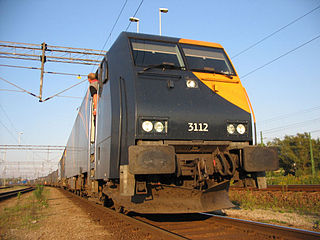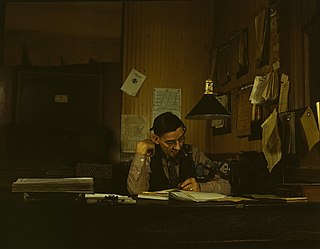Related Research Articles

A train is a series of connected vehicles that run along a railway track and transport people or freight. Trains are typically pulled or pushed by locomotives, though some are self-propelled, such as multiple units or railcars. Passengers and cargo are carried in railroad cars, also known as wagons or carriages. Trains are designed to a certain gauge, or distance between rails. Most trains operate on steel tracks with steel wheels, the low friction of which makes them more efficient than other forms of transport.

A conductor or guard is a train crew member responsible for operational and safety duties that do not involve actual operation of the train/locomotive. The conductor title is most common in North American railway operations, but the role is common worldwide under various job titles. In Commonwealth English, a conductor is also known as guard or train manager.

A caboose is a crewed North American railroad car coupled at the end of a freight train. Cabooses provide shelter for crew at the end of a train, who were formerly required in switching and shunting, keeping a lookout for load shifting, damage to equipment and cargo, and overheating axles.
Rail transport operations are the day-to-day operations of a railway. A railway has two major components: the infrastructure and the rolling stock

A dispatcher is a communications worker who receives and transmits information to coordinate operations of other personnel and vehicles carrying out a service. Emergency organizations including police departments, fire departments, and emergency medical services departments as well as civilian organizations such as motorcycle couriers, taxicab providers, trucking companies, railroads, bus systems, and public utility companies, use dispatchers to relay information, direct personnel, and coordinate their operations.

A rail yard, railway yard, railroad yard (US) or simply yard, is a series of tracks in a rail network for storing, sorting, or loading and unloading rail vehicles and locomotives. Yards have many tracks in parallel for keeping rolling stock or unused locomotives stored off the main line, so that they do not obstruct the flow of traffic. Cars or wagons are moved around by specially designed yard switcher locomotives (US) or shunter locomotives (UK), a type of locomotive. Cars or wagons in a yard may be sorted by numerous categories, including railway company, loaded or unloaded, destination, car type, or whether they need repairs. Yards are normally built where there is a need to store rail vehicles while they are not being loaded or unloaded, or are waiting to be assembled into trains. Large yards may have a tower to control operations.
On February 8, 1986, 23 people were killed in a collision between a Canadian National Railway freight train and a Via Rail passenger train called the Super Continental, including the engine crews of both trains. It was the deadliest rail disaster in Canada since the Dugald accident of 1947, which had 31 fatalities, and was not surpassed until the Lac-Mégantic rail disaster in 2013, which resulted in 47 deaths.

On January 4, 1987, two trains collided on Amtrak's Northeast Corridor main line near Chase, Maryland, United States, at Gunpow Interlocking. Amtrak train 94, the Colonial, traveling north from Washington, D.C., to Boston, crashed at over 100 miles per hour (160 km/h) into a set of Conrail locomotives running light which had fouled the mainline. Fourteen passengers on the Amtrak train died, as well as the Amtrak engineer and lounge car attendant.

A brakeman is a rail transport worker whose original job was to assist the braking of a train by applying brakes on individual wagons. The advent of through brakes, brakes on every wagon which could be controlled by the driver, made this role redundant, although the name lives on, for example, in the United States where brakemen carry out a variety of functions both on the track and within trains.

A train dispatcher (US), rail traffic controller (Canada), train controller (Australia), train service controller (Singapore) or signaller (UK), is employed by a railroad to direct and facilitate the movement of trains over an assigned territory, which is usually part, or all, of a railroad operating division. The dispatcher is also responsible for cost effective movement of trains and other on-track railroad equipment to optimize physical (trains) and human resource (crews) assets.

The Fort Eustis Military Railroad is an intra-plant United States Army rail transportation system existing entirely within the post boundaries of the United States Army Transportation Center and Fort Eustis (USATCFE), Fort Eustis, Virginia. It has served to provide railroad operation and maintenance training to the US Army and to carry out selected material movement missions both within the post and in interchange with the US national railroad system via a junction at Lee Hall, Virginia. It consists of 31 miles (50 km) of track broken into three subdivisions with numerous sidings, spurs, stations and facilities.

One-person operation (OPO), also known as driver-only operation (DOO), one-man operation (OMO), single person train operation (SPTO), or one-person train operation (OPTO), similarly to Driver Controlled Operation, is operation of a train, bus, or tram by the driver alone, without a conductor.

MacMillan Yard is the main Toronto-area railway classification yard for Canadian National Railway (CN), and is located in the nearby suburb of Vaughan, Ontario. It is the second largest railway classification yard in Canada, after CN's Symington Yard in Winnipeg, Manitoba. It was originally opened in 1965 as Toronto Yard, but was renamed MacMillan Yard in 1975 after former CN president Norman John MacMillan.

The 2008 Chatsworth train collision occurred at 4:22:23 p.m. PDT on September 12, 2008, when a Union Pacific Railroad freight train and a Metrolink commuter rail passenger train collided head-on in the Chatsworth neighborhood of Los Angeles, California, United States.
This article lists some of the terminology used at present and in the past by railway employees, railway enthusiasts and railway historians in Australia. Many appear from time to time in specialist, rail-related publications. Significant regional variations exist, indicated by abbreviations of the state or railway.

The yardmaster is a railroad employee in charge of a rail yard. Duties involve managing and coordinating all activities in combining rolling stock into trains, breaking down trains into individual railroad cars, and switching trains from track to track in the rail yard. In the United States of America, yardmasters are eligible to join the Railroad Yardmasters of America.

A switchman also known as pointsman or yardman (Commonwealth) is a rail transport worker whose original job was to operate various railway switches or points on a railroad. It also refers to a person who assists in moving cars in a railway yard or terminal.

The Harvey train collision took place on October 12, 1979, when the Shawnee train operated by Amtrak between Carbondale and Chicago Union Station crashed into a parked Illinois Central Gulf freight train, leading to the death of two crew members.

Cedar Hill Yard is a classification yard located in New Haven, North Haven and Hamden, Connecticut, United States. It was built by the New York, New Haven and Hartford Railroad in the early 1890s in and around New Haven's Cedar Hill neighborhood, which gave the yard its name. Electrical catenary for electric locomotives was added to the yard in 1915. To handle increasing traffic as a result of World War I, the yard was greatly expanded between 1917 and 1920 with additional construction along both sides of the Quinnipiac River. The construction project added two humps where railroad cars were sorted into trains by gravity. The yard was further modernized in the 1920s, becoming one of the busiest railroad yards in the United States, and the most important yard in the entire New Haven Railroad system.
References
- ↑ Lindzon, Jared (13 May 2015). "I want to be a train conductor. What will my salary be?". The Globe and Mail.
There are no formal educational requirements for train conductors. However, each is put through a rigorous training program provided by their employer